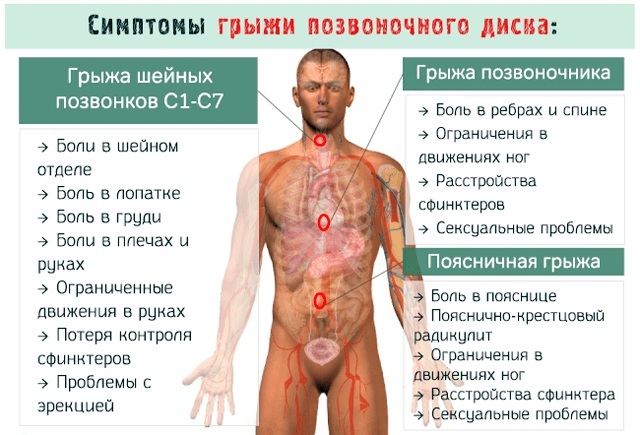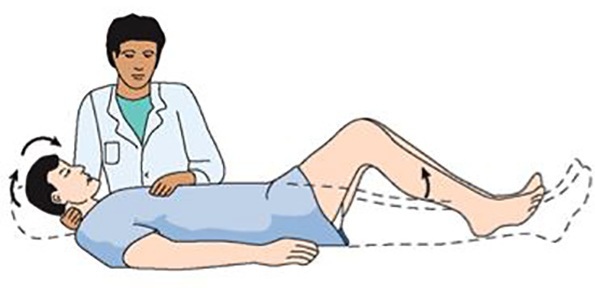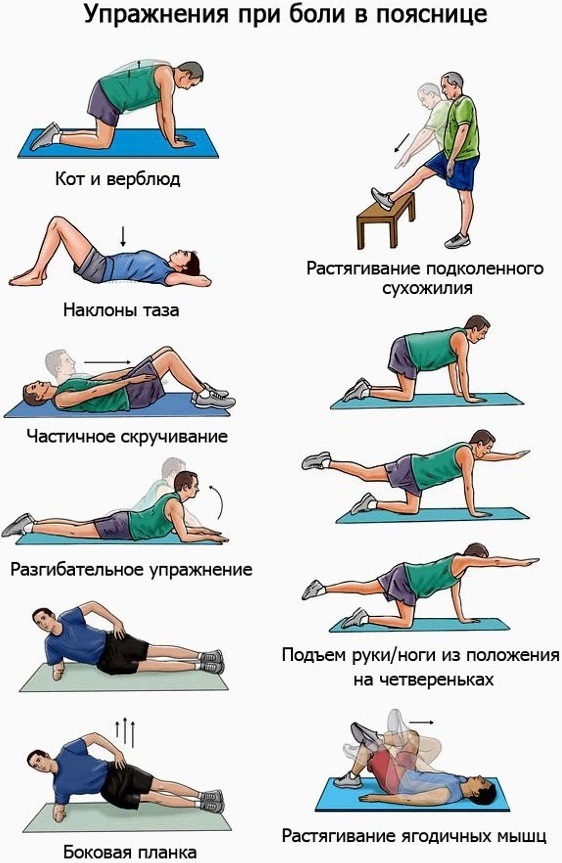Painful manifestations in the back and limbs neurologists are evaluated according to the symptomatology characteristic of each disease. Of no small importance in the diagnostic process is the development of the Italian doctor Neri, named after its discoverer.
Record content:
- 1 What is Neri's symptom?
- 2 The reasons for the formation of the syndrome
- 3 Degrees
- 4 What does this research method reveal?
- 5 Diseases in which there is
- 6 How is the research done?
- 7 What does a positive test indicate?
- 8 False positive result
- 9 Clinical picture
- 10 Treatment
- 11 Neurological Disease Videos
What is Neri's symptom?
Neri's symptom in neurology is one of the signs of tension and allows you to determine pain in the case of damage to the posterior spinal roots. During the study, pain appears in the lumbar region and can spread along the zone of innervation of the sciatic nerve, provoking pain in the lower limb and pelvic muscles.
The reasons for the formation of the syndrome
The causal factor in the development of a symptom is any pathology that accompanied by damage to the posterior roots of the spinal cord:
- the formation of osteophytes (bone formations) of the spine;

- inflammatory processes in the muscles and ligaments of the spinal column;
- change in configuration, protrusion or hernia of the intervertebral disc;
- myeloradiculopathy (radiculitis) at the level of the lumbar spine;
- inflammatory lesion of the nerve roots;
- muscle contraction as a result of cooling.
The key link in the mechanism of the development of Neri's symptom is compression or inflammation of the posterior roots, more often in the range from 3 lumbar to 1 sacral vertebra. With the development of a herniated disc, its annulus fibrosus is destroyed, due to which the disc nucleus protrudes beyond the spinal segment, squeezing one or more roots.
The symptom in question often develops against the background of destructive changes in the intervertebral discs. Age-related changes, trauma, posture disorders provoke a negative effect on the structure of the vertebrae and intervertebral joints.
This leads to rapid disc wear, increased load on the ligamentous apparatus, the ligaments become thicker and accumulate lime in themselves. A large amount of the calcareous component causes unwanted bone growth, irritating the spinal roots.
Direct trauma to the spinal column also leads to the defeat of the roots, especially with an unstable fracture of the vertebrae or fracture-dislocation of the spinal column. Stab wounds in the area of the spinal column can also be attributed to the same category.
Degrees
Depending on the clinical manifestations and the extent of the lesion of the spinal roots, 3 degrees of severity can be distinguished - mild, moderate and severe.
| Mild degree | Average degree | Severe degree | |
| Pain characteristic | The appearance of pain during the study. | Significant pain during the study; rarely - the presence of pain on an ongoing basis. | Painful sensations are always present, during the study they intensify; unbearable pain. |
| Damage volume | More often within one spine (one pair). | One or more pairs of roots. | More often, more than one pair of roots is affected. |
| Irradiation of pain in the lower limb and pelvic muscles. | Seldom | Often | Often |

Additionally, the degree of severity of this symptom can be determined by the degree of the angle to which it was possible to deflect the head without the appearance of pain.
What does this research method reveal?
Neri's symptom in neurology serves as a tool for determining the presence and localization of radicular lesions in many neurological pathologies that cause compression of the posterior roots of the spinal cord in the lumbar region segments. Therefore, neurologists and neurosurgeons use this technique for topical and differential diagnosis.
Diseases in which there is
In neurology, osteochondrosis is the most common cause of a positive Neri symptom. This is a disease of multifactorial etiology, characterized by degenerative damage to the structures of the spine.
Starting from the nucleus of the intervertebral disc, the process moves to the annulus fibrosus, and then to others. constituents of the segment, which causes characteristic neurological symptoms, including a symptom Neri.
Disc degeneration starts when protein destructive reactions dominate over synthetic ones, this happens in conditions of insufficient nutrition.
Older patients are most susceptible to such changes, since as the intervertebral disc grows, it undergoes processes which the number of vessels supplying blood to the tissue becomes less and the intensity of the intake of nutrients decreases.
Failure to reproduce at the proper volume causes the disc density to decrease. Insufficient density reduces the damping function and the normal redistribution of the vertical load becomes impossible.
Constant compression of the disc leads to disruption of tissue organization and rupture of the annulus fibrosus, and unnatural mobility and protrusion of the disc nucleus compress the surrounding tissues, including the posterior roots.
A herniated disc as an independent disease, regardless of the development of osteochondrosis, is also the cause of the Neri symptom.
Sciatica is another inflammatory disease characterized by irritation of the posterior roots of the spinal cord and the onset of Neri's symptom in the lumbosacral form, when the pain spreads to the thigh, lower leg and foot. Such sciatica has the trivial name "sciatica".
Myositis of the paravertebral muscles is an inflammatory disease of muscle tissue that occurs against the background of the action of any agent or factor that initiates inflammation.
The involvement of the root in the muscle bed in the inflammatory process can cause persistent neurological symptomatology, and if localized in the region from 3 lumbar to 1 sacral vertebra, a symptom may appear Neri.
A neurinoma is a benign neoplasm that develops from the sheath of a nerve. Most often, women of any age get sick. Depending on the location of the tumor, it causes characteristic symptoms. Localized in the corresponding segments of the spinal column (from 3 lumbar to 1 sacral), it can manifest itself as a symptom of Neri as a result of root compression.
Spinal tumors can lead to this syndrome. By disrupting the configuration of the spinal column, persistent compression of the surrounding tissues occurs together with the posterior roots of the spinal cord. Such compression in the lumbar region can provoke a symptom of Neri.
How is the research done?
Neri's symptom in neurology is checked on a flat surface, the patient lies on his back, legs are straightened, a neurologist or neurosurgeon puts his hand under the back of the patient's head and, with a sharp movement, brings his head to breasts.
If the nerves of the spinal cord are involved in this process, then the subject experiences pain in the projection of the affected area. During the study, the patient's upper body does not rise, as with the tension of the occipital muscles. It is also possible for the patient to perform these actions independently.
If pain in the lumbar region appears even with minor movements, then Neri's symptom is always positive. Most often, this phenomenon is observed when the nerve root is pinched.
Mild pain that disappears within 15-20 days can cause a false negative result. After a while, pain may appear in the lower limb.
What does a positive test indicate?
A positive test for Neri's symptom indicates primary or secondary dorsal root involvement. spinal cord localized in the lumbar region, more often in the projection of segments from 3 lumbar to 1 sacral.
Such symptoms should serve as a basis for the attending physician for further examination, determination of the etiological factor of irritation and the subsequent tactics of patient management.
False positive result
Incorrect results may be associated with mental disorders of the patient; hypochondriacs and cyberchondriacs are prone to this. With cyberchondria, disorders are expressed in a craving for self-diagnosis, which usually occurs after acquaintance with the symptoms of a certain disease on the Internet.
Cyberchondria is not isolated as a separate disease, experts define it as a type of hypochondria.
Hypochondria is registered in the international classification of diseases and is defined as a disorder accompanied by regular worrying thoughts about the likelihood of getting sick.
The hypochondriac accepts the normal sensations of his body as pathological and unpleasant, believes that he is sick and makes false complaints. He is characterized by an unstable conviction that he is sick with one or another disease. The disease is found more often in depressed and anxious people with some personality traits.
Any other pathology localized in the lumbar region can become the cause of a false result, but without involvement in the process of the roots of the spinal cord (contusion of soft tissues in the lumbar region, sprain of ligaments and muscles, toxic defeat).
Low back pain manifests itself in many infectious diseases, accompanied by lesions of the spine, rheumatoid arthritis, Reiter's syndrome, which can lead to a false positive result when tested for Neri's symptom.
Clinical picture
Neri's symptom in neurology is accompanied by clinical manifestations characteristic of the disease causing it. Along with Neri's symptom with osteochondrosis, the patient will complain of pain, numbness and muscle weakness in the affected area.
Mobility disturbances, suppression of the function of the pelvic organs are possible. Patients with osteochondrosis are usually over 35 years old, spinal injuries during life, curvature of the spine, or work associated with hard physical labor and poor posture are possible.
Herniated discs are more often observed in able-bodied people and are characterized by neurological symptoms, including Neri's symptom. Pain appears long before the hernia appears as such, usually during physical exertion. With an intervertebral hernia, the symptomatic picture will be different.
With a lesion at the level of 3-4 lumbar vertebrae, the pain spreads to the front and inner surface of the thigh, lower leg and inner ankle, sensitivity on the front of the thigh decreases, weakness of the thigh muscles increases, the knee disappears reflex.
If the lesion is at the level of 4-5 lumbar vertebrae, then the pain will spread to the outer surface of the thigh and lower leg, on the thumb, index and middle fingers, there is a depression of sensitivity in the same areas, possibly weakness muscles.
Pathology at the level of 5 lumbar and 1 sacral segments pain radiates to the gluteal region and the back of the thigh and lower leg, heel and ring finger with little finger. There is muscle weakness in these areas. Very often, the symptoms of a hernia disappear after a few weeks.
With sciatica, clinical manifestations are characterized by pain at the level of the lesion, decreased sensitivity and motor function. Radiculitis begins acutely and often becomes chronic. Along with the symptom of Neri with lumbosacral radiculitis, the pain spreads along the gluteal region and further to the lower limb to the foot.
It becomes stronger during movement, so patients try not to allow sudden movements, and in a supine position they bend the leg. Feeling of numbness and "goose bumps" is characteristic.
The general symptom of myositis is muscle pain in the area of inflammation. Pain increases with movement or pressure on the affected muscle, so movement in the joints becomes limited to relieve pain.
Redness of the skin and an increase in its temperature are visually observed. With the progression of the disease, muscle weakness occurs, the patient may lose the ability to serve himself.
Spinal root neuroma is accompanied by symptoms of irritation and compression of the spinal cord. A neuroma at the level from 3 lumbar to 1 sacral segments will have a picture approximately similar to sciatica or intervertebral hernia: pain in the projection of the neuroma, radiating to the lower limb and pelvic muscles, muscle weakness, impaired motor functions.
For spinal cord tumors, the earliest symptom is progressive pain syndrome, which is not dependent on physical activity and increases in the supine position. Pain is localized more often in the back, it can spread to other areas along the root.
Neurological symptoms increase with damage to the spinal cord, weakness and urinary incontinence are characteristic. Possible violation of sensitivity, depression of the intestines and bladder.
Treatment
Treatment of Neri's symptom is directly related to the disease in which it manifests itself, therefore, methods are used for treatment that act on the cause of the underlying disease.
With osteochondrosis, the tactics are conservative and are aimed at 3 points:
- Fighting pain syndrome.
- Prevention of functional disorders of the spinal roots.
- Minimizing the consequences of dystrophic processes in the spinal column.
If conservative treatment is ineffective, then they resort to surgery. The scope of the operation is determined based on the clinical process and the level of lesions.
The time of treatment is directly proportional to the neglect of the process, the presence of complications, the age of the patient, and methods of treatment. Conservative treatment lasts up to 3 months; during the operation, the recovery period may take more than a year.
At the start of the treatment of osteochondrosis, a more severe pain syndrome may appear, which is associated with the body's response to influences of a different nature. The pain is quickly relieved with the use of physiotherapy, exercise therapy and medication.
The effectiveness of therapy is highly dependent on the patient himself. He needs patience and some willpower. After the operation, rehabilitation is usually carried out in special centers and sanatoriums with good equipment.
Conservative methods include exercise therapy, physiotherapy, drug therapy, and massages. The most basic component is physiotherapy exercises, during which the patient regularly performs exercises with dosed loads to strengthen the musculoskeletal system and improve blood supply.
In physiotherapy, ultrasonic and laser devices, devices operating with low-frequency currents are used - they can relieve pain. Massages help relax muscles and relieve pain by improving blood supply to tissues.
Thanks to the manual action on the musculoskeletal system, acute pain is relieved and posture improves. Traction of the spinal column is applied with the use of equipment and selection of loads.
With herniated spinal discs, in more than half of the cases, persistent remission occurs and surgical intervention is not required. The operation is resorted to only as a last resort, when conservative treatment is ineffective, and the pain syndrome and neurological symptoms are progressing.
Conservative therapy is based on the use of anti-inflammatory drugs and muscle relaxants. This tactic reduces the body's inflammatory response and reduces the compressive effect on the root. Another important component of treatment is exercise therapy.
With sciatica, treatment tactics are aimed at eliminating its cause. The main role is played by physiotherapy and exercise therapy. From medications, pain relievers are used.
Various ointments and rubbing agents are very effective for radiculitis. It takes about 20 minutes. she came down to rub the place where the pain is localized. After such a massage, it is necessary to provide this area with warmth.
Myositis requires an individual approach to treatment. In addition to physiotherapeutic methods, anti-inflammatory ointments with diclofenac or ketoprofen are used to relieve pain, pain relievers can be taken.
In the case of the presence of an elevated temperature, it is necessary to attach antipyretic drugs to the therapy. Muscle spasm can be stopped by drugs containing snake venom.
Treatment of neuromas is performed mainly promptly, however, in the case of large volumes of education, and also when it is impossible to remove it, radiation therapy is used. Often, after surgical treatment, the neuroma is eliminated without a trace.
For spinal cord tumors with persistent neurological symptoms and significant spinal lesion brain therapy with corticosteroids is indicated - first intravenously, and then oral administration of dexamethasone. It is important to start treatment as early as possible, because the lesions can become irreversible, then the Neri symptom will always be positive.
With a successful location of the tumor, it can be removed by surgery, in 50% of patients after surgery, the condition becomes better. If the tumor does not respond to surgical treatment, then radiation therapy with surgical decompression is used.
Compression metastases are surgically removed and then radiation therapy is applied. Non-compression metastases can only be treated with radiation therapy.
Neurological Disease Videos
About sciatica lumbar:



